Veloster attracts new attention to Hyundai
By John Gilbert
My co-driver in the passenger seat said, “Look at that guy.†I couldn’t look, being occupied in the left lane, dodging celebratory lane-swervers heading north on Interstate 5, on the way from Eugene to Portland, Oregon. My co-driver filled me in: “He’s driving that SUV, and he just pulled out his cell phone to take a picture of this car.â€
We were driving a 2012 Hyundai Veloster, an unusual car covered with grooves and contours that make it a unique expression of a sports coupe. Our day had been consumed by driving down I-5, from Portland to Eugene, where we did a little tailgating and watched the University of Oregon overrun Nevada 69-20 in a college football blowout. On the way down, I had plugged in my iPod and tuned it to Greg Brown’s Iowa folksy songs, singling out “Eugene,†his rambling travelogue about places he likes to visit all across the country, with Eugene, Ore., among them.
My partner enjoyed that song so much he asked me to play it again on our return trip late that Saturday afternoon.
The occasion for all this was the introduction of the 2012 Veloster, and it was combined to give us access to nightly live music at the Northwest Music Fest being held at dozens of venues throughout Portland, as well the 2-hour drive to the football game, one day after we had driven to the Columbia River Gorge. Hyundai could have sold a half dozen Velosters on our Gorge trip, when we arrived as a posse of more than a dozen multi-colored Velosters stopping at the Vista House on Crown Point, looking down on the scenery, while we were promptly surrounded.
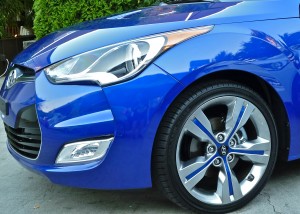
 Alloy wheels have a neat twist, with a strip running down each spoke that matches Veloster vehicle color..
The cars attracted considerable attention wherever we drove. That included the royal blue Veloster we drove to Eugene, and the bright white one that brought us back. A neat touch on the colored Velosters is that the distinctive alloy wheels have an accent strip running longitudinally down each spoke matching the color of the vehicle.
We switched cars to drive both the 6-speed stick shift version and the 6-speed automatic, which isn’t really an automatic but a “DCT,â€Â Hyundai’s own dual-clutch direct-sequential transmission. With no clutch pedal, two dry clutches inside the gearbox alternate with one handling first, third and fifth while the other engages second, fourth and sixth. If you leave them alone in “D†the car shifts with smooth precision; if you click the paddles on either side of the steering wheel, you can manually downshift with the left paddle or upshift with the right one, also smoothly and instantly.
Hyundai continues on its amazing roll, featuring the rollout of the Sonata, Genesis, Equus, Elantra, Accent, Tucson and Santa Fe in the last two years, and equally important, such technical advances as its gas direct-injection (GDI) fuel system, and its own 6-speed automatic transmission. The South Korean company is far from resting on its considerable laurels, however. It already is introducing an 8-speed automatic for its larger Genesis and Equus, and it has expanded its GDI technology from the 2.4-liter 4, to the 3.8 V6, and now to the all-new 5.0 V8, and in the overachieving 1.6-liter 4 that powers both the Accent and the Veloster.
Beyond the Veloster’s name and its multi-grooved shapeliness, its uniqueness includes being a 3-door coupe. As you approach the driver’s door, you see one large door, and if you approach the right side, you also see one door, though slightly less large to house what you don’t readily see — a second door on the right side, opening with a cleverly hidden hand-grip that is fashioned in flat black to blend into the rear window’s rear molding. Open it, and you find easy access to a quite-roomy rear bench seat, behind the two supportive buckets up front.
A key selling point of the Veloster is that it may be quick and agile, but it also will attain 40 miles per gallon on the highway. EPA estimates are 28 city and 40 highway for the stick, and 29/38 for the DCT automatic. Hyundai engineers explained that the DCT actually will get better mileage in city driving, while the stick will do slightly better on the freeway.
Hyundai looks at the newly revised Beetle, Mini Cooper Clubman, Honda CR-Z, and Scion tC among competitors for the Veloster, and claims that Veloster has a price advantage ranging from $1,245 to $2,500 against all of them. As a sporty coupe, the Veloster is priced from $17,300 with the manual transmission, to $19,300 with the DCT. Naturally, you can start loading up either model with options, such as a panoramic sunroof, a premium audio system with external amplifier, subwoofer and eight speakers, and a tech package, with navigation system, rearview camera, and all the sort of goodies you might expect on a larger, higher-priced car.
The small-displacement 1.6-liter 4 is properly high-tech. Starting with dual overhead camshafts, the all-aluminum 4 has direct injection, which feeds fuel, metered precisely with controlled pressure and temperature, independently into each cylinder, a technique that produces optimum power and fuel economy, and also is aimed at eliminating any pre-ignition challenges. The engine has a timing chain instead of a belt, making it maintenance-free, and it has an offset crankshaft to smooth out harmonic vibrations. Electronic throttle control, and variable induction, increase engine performance in all speed ranges. In addition, it has dual variable valve-timing, widening the flexibility range of the valves’ timing duration, which improves torque.
Performance of the Veloster is quick and handling agile, which renders its modest specifications meaningless. The engine turns out only 138 horsepower at 6,300 RPMs, and 123 foot-pounds of torque at 4,850 RPMs, but it drives and handles with potency beyond those numbers.
To make the Veloster as strong and light as possible, Hyundai made liberal use of high-grade steel. Its construction is 42 percent high-tensile steel, and 23 percent ultra-high-tensile, making a total of 65 percent high-strength steel. High-strength steel is costly but means car-makers can use thinner gauge steel for lighter weight but still make it stronger than less-expensive conventional steel. Hyundai gets around the expense by being the only auto-maker that owns its own steel plant.
Volkswagen sells a high-level sporty model of the Golf in Europe, called the Scirocco, and Hyundai engineers say the Veloster is lighter, stronger and stiffer, with a 32.8 Hz. rating compared to the Scirocco’s 23.1. The firmness equates to a much more tuneable performance suspension, without any harshness, while helping the Veloster to the No. 1 rank in its class for wind noise, road noise and both low and high frequency noise intrusion.
Suspension agility can be traced to the independent MacPherson struts with gas-charged shocks and a 24-mm stabiizer bar in front, while the rear has a torsion beam axle with monotube shocks, and a 23-mm stabilizer bar.
Veloster’s aim for 5-star safety includes, all standard: 4-wheel disc brakes, front seatbelt pre-tensioners, six airbags to protect from the front, front-side, and side, anti-lock brakes with electronic brake-force distribution and brake assist, plus electronic stability control, and traction control.
While the Veloster borrows the 1.6-liter GDI Gamma engine from the Accent, its platform is based more on the longer Elantra, which adds weight and stability, but means the Veloster can’t match the Accent’s amazing fuel economy, which starts out at 40 highway and reached and observed high of 47 during our introductory highway tests a month earlier.
After the Sonata, Veloster is Hyundai’s second vehicle to have blueLink, which might overmatch the connectivity benefits of most competitors. Among its more elementary operations are finding points of interest, gas stations, and restaurants, and alerting you to daily traffic congestion ahead, weather issues, as well as route guidance.
Among its more sophisticated elements are the embedded telematics through its cellular network, which uses voice recognition to summon up roadside assistance, emergency notification if the car is involved in an accident, warranty alerts, and all sorts of other information. Push the button on the side of the rear-view mirror, and the attendant will tell you your exact location — in case you feel lost despite the navigation system. It converts the Veloster into a giant cell-phone by allowing you to send text messages, remotely lock or unlock the car, remotely start the car, and remotely activate the lights and horn, all by voice commands.
If you might be letting your favorite teenager drive the car at night, or worse, if the car is stolen, more features will be well-appreciated, such as a curfew alert or speed alert, to let you know if Junior is drag-racing his buddy, as well as a valet alert, all activated via your cell phone. You can even trigger a panic alarm, and in the event your Veloster is stolen, you could use the system to cause your vanishing Veloster to slow down, and even immobilize the vehicle.
I suggested if Hyundai is that advanced, perhaps the next step in retrieving a stolen Veloster would be to slow down and stop the car, then tighten the seat harness and disable the unlatch feature, then lock all the doors to keep the perpetrator inside until the cops arrive. We may not want Big Brother watching us, but we sure wouldn’t mind him watching over our cars.
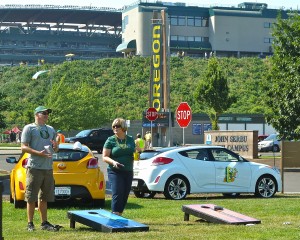
Tailgating party featured Velosters, and media-types flinging bean bags, before Oregon crushed Nevada 69-20.
Along with all the impressive connectivity outlets, you can play some economy games with your Veloster, switching the instrument screen to eco-drive information, or you could go to BlueMax, which will keep score of how well you’re driving for optimum fuel efficiency.
Because it handles so well and is so fun to drive, you may be tempted to keep stepping on the gas in the Veloster more than optimum fuel economy might allow. But appearances can mean a lot. Passers-by at a rest stop aren’t likely to surround just a boxy subcompact, and you won’t find SUV drivers on the interstate jockeying for position and risking life and limb to snap a cell-phone photo of just any 40-mpg sedan.
Comments
One Comment on Veloster attracts new attention to Hyundai
-
love app on
Wed, 27th Jul 2016 3:23 pm
I believe this is among the so much important info for me.
And i’m happy studying your article. But should remark on some normal issues,
The web site taste is wonderful, the articles is really
excellent : D. Excellent job, cheers
Check out my web blog … love app
(Glad to supply the info…JG)
Tell me what you're thinking...
and oh, if you want a pic to show with your comment, go get a gravatar!


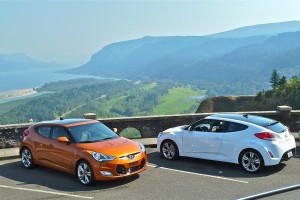
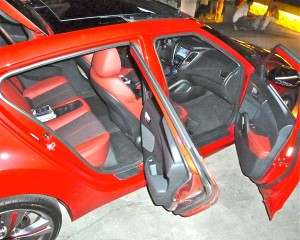
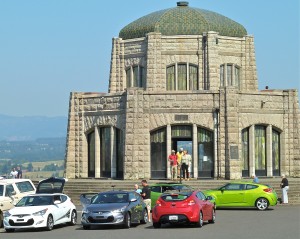
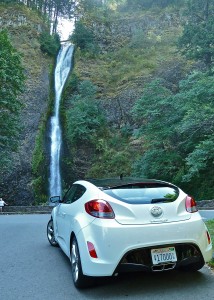
 John Gilbert is a lifetime Minnesotan and career journalist, specializing in cars and sports during and since spending 30 years at the Minneapolis Tribune, now the Star Tribune. More recently, he has continued translating the high-tech world of autos and sharing his passionate insights as a freelance writer/photographer/broadcaster. A member of the prestigious North American Car and Truck of the Year jury since 1993. John can be heard Monday-Friday from 9-11am on 610 KDAL(www.kdal610.com) on the "John Gilbert Show," and writes a column in the Duluth Reader.
John Gilbert is a lifetime Minnesotan and career journalist, specializing in cars and sports during and since spending 30 years at the Minneapolis Tribune, now the Star Tribune. More recently, he has continued translating the high-tech world of autos and sharing his passionate insights as a freelance writer/photographer/broadcaster. A member of the prestigious North American Car and Truck of the Year jury since 1993. John can be heard Monday-Friday from 9-11am on 610 KDAL(www.kdal610.com) on the "John Gilbert Show," and writes a column in the Duluth Reader.